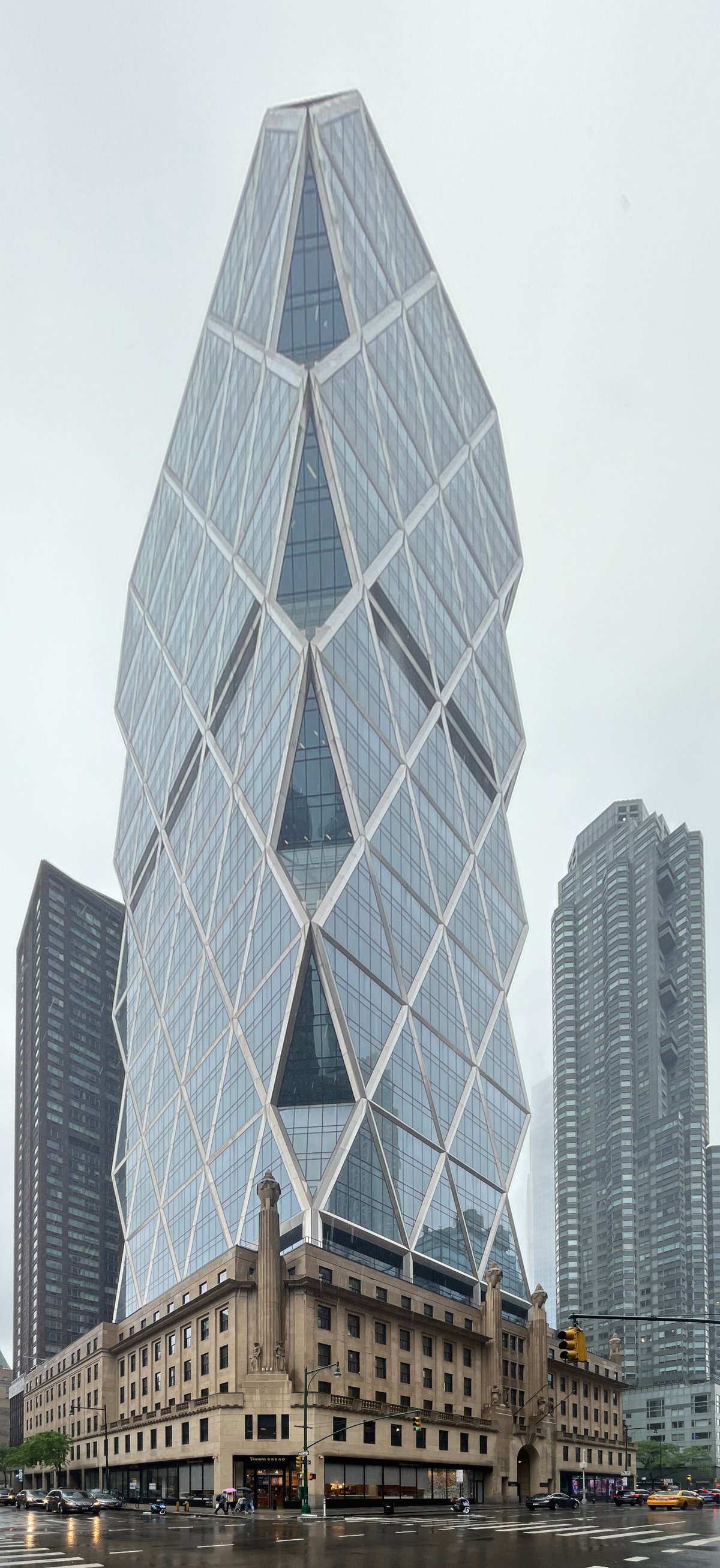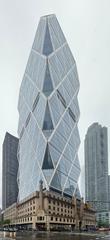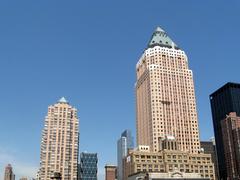
Hearst Tower New York City: Visiting Hours, Tickets, and Historical Sites Guide
Date: 14/06/2025
Introduction to Hearst Tower in New York City
The Hearst Tower stands as a striking symbol of architectural evolution and sustainable innovation in Midtown Manhattan. Commissioned in 1928 by William Randolph Hearst and designed by Joseph Urban, its original six-story Art Deco base was envisioned as a foundation for future expansion. This vision was realized in 2006 when Sir Norman Foster added a dramatic glass-and-steel diagrid tower atop the historic base, creating a unique dialogue between old and new. Today, Hearst Tower is celebrated for its pioneering environmental features and its role as the world headquarters for Hearst Communications. Although public access is limited, visitors can explore select areas and appreciate the tower’s architectural significance, sustainability achievements, and urban presence. For current visiting hours, tours, and events, consult the official Hearst Tower website and related resources (Hearst Tower Official Site, WikiArquitectura, Hearst Sustainability 2024).
Table of Contents
- Introduction
- Visiting Hours and Tickets
- Guided Tours and Special Events
- Accessibility Information
- Historical Background and Architectural Significance
- Location and Urban Context
- Nearby Attractions and Visitor Tips
- Visuals and Media
- Frequently Asked Questions (FAQs)
- Plan Your Visit
- Conclusion
Visiting Hours and Tickets
Hearst Tower functions primarily as a private office building, restricting public access to certain areas. The lobby and atrium are open to visitors Monday through Friday, typically from 8:00 AM to 6:00 PM, although hours may vary. Admission to publicly accessible spaces is free; there are no tickets required for general entry. Guided tours and event access are only available by appointment or during special events such as Open House New York. For up-to-date information on access and tour availability, check the official website.
Guided Tours and Special Events
Public tours are rare, but Hearst Tower periodically participates in architecture festivals and events like Open House New York, offering limited guided tours by advance registration. These tours provide a behind-the-scenes look at the building’s design, sustainability features, and history. For event schedules and registration, visit Open House New York and related listings.
Accessibility Information
Hearst Tower is fully accessible for visitors with disabilities. The main entrance at 300 West 57th Street features ramps and automatic doors, and elevators connect all public floors. Assistance is available upon request—visitors with accessibility needs are encouraged to contact building security or guest services prior to arrival (Hearst.com).
Historical Background and Architectural Significance
Origins and Early History
The tower’s story began in 1928 when William Randolph Hearst commissioned Joseph Urban to design a new headquarters for his media empire. The resulting six-story base, completed just before the Great Depression, was constructed with a robust Art Deco limestone façade featuring allegorical figures symbolizing Hearst’s wide-ranging journalistic pursuits (WikiArquitectura). The base was intended as a foundation for a future tower, which remained unrealized for decades.
Foster’s Modern Transformation
In the early 2000s, Hearst Corporation consolidated its offices and selected Norman Foster to reimagine the site. Foster preserved the historic base and designed a 46-story glass-and-steel tower above, employing a daring architectural approach. The two structures create a visually powerful juxtaposition, with meticulous restoration of the base and a soaring atrium that unites old and new (Foster + Partners).
The Diagrid Structural System
Unlike traditional skyscrapers, Hearst Tower uses a diagrid—a diagonal steel grid—eliminating the need for vertical columns at the building’s perimeter. This innovation reduced steel usage by approximately 20%, making the building both lighter and more resource-efficient. The diamond-patterned façade, formed by four-story triangular frames, is instantly recognizable and helps maximize natural light throughout the interior (WikiArquitectura).
Sustainability and Environmental Leadership
Hearst Tower is a pioneer in green architecture, earning New York City’s first LEED Gold certification for core and shell, and later Platinum certification for Existing Buildings (Hearst Sustainability 2024). Key features include:
- Recycled Materials: Over 90% of structural steel contains recycled content; most construction materials were sourced domestically.
- Water Management: Rainwater harvested from the roof is reused for irrigation and the three-story Icefall water feature, reducing stormwater runoff by 25%.
- Energy Efficiency: The building uses 26% less energy than code-compliant towers, aided by smart lighting, occupancy sensors, and high-performance glazing.
- Waste Reduction: Initiatives such as composting, recycling, and the elimination of single-use plastics are part of daily operations, setting standards for urban sustainability (MIT OCW PDF).
Artistic and Cultural Features
The preserved base features allegorical sculptures and Art Deco detailing, while the interior includes the Joseph Urban Theater, a broadcast studio, and curated art exhibitions like KangHee Kim’s “The Vertical City.” These elements reflect Hearst’s legacy in media and design (Hearst.com).
Location and Urban Context
Located at 300 West 57th Street, at the intersection with Eighth Avenue, Hearst Tower is steps from Columbus Circle and Central Park. Its crystalline tower rises above the historic base, forming a dramatic silhouette in Midtown Manhattan. The building is easily accessible by subway via the 59th St.–Columbus Circle and 57th St.–Seventh Ave stations. Improvements to the adjacent subway entrance were made as part of the tower’s development, enhancing accessibility for the wider community (MIT OCW PDF).
Nearby Attractions and Visitor Tips
Hearst Tower’s central location makes it ideal for combining with other iconic NYC sites:
- Central Park: 5-minute walk north
- Columbus Circle: 2-minute walk
- Lincoln Center: 10-minute walk
- Museum of Arts and Design: Across from Columbus Circle
- Theater District and MoMA: Short walk east
For the best exterior views and photos, visit during daylight hours—golden hour provides spectacular lighting on the tower’s angular forms (Loving New York). Comfortable shoes and weather-appropriate attire are recommended.
Visuals and Media
Alt text: Hearst Tower exterior showcasing the unique diagrid steel frame in Midtown Manhattan
Alt text: HearstLive LED multimedia installation visible from the sidewalk at Hearst Tower
Alt text: Interior view of Hearst Tower’s atrium featuring the three-story Icefall fountain
High-quality images and virtual tours are available on the Hearst Sustainability website.
Frequently Asked Questions (FAQs)
Q: What are the Hearst Tower visiting hours?
A: The lobby and atrium are accessible Monday–Friday, generally 8:00 AM–6:00 PM. There is no public observation deck.
Q: Do I need a ticket to visit?
A: No ticket is required for public areas. Special tours require advance registration.
Q: Are public tours available?
A: Only during special events such as Open House New York, and by advance registration.
Q: Is Hearst Tower accessible for people with disabilities?
A: Yes, with ADA-compliant entrances, elevators, and accessible sidewalks.
Q: Is photography allowed?
A: Photography is permitted outside and in the lobby; interior photography requires authorization.
Plan Your Visit
- Address: 300 West 57th Street, New York, NY 10019 (Hearst.com)
- Nearest Subway: 59th St.–Columbus Circle (1, A, B, C, D lines)
- Contact: (212) 649-2000
- Official Website: hearst.com
To maximize your experience, combine your visit with nearby attractions and check for special events or tours on the official site and Open House New York.
Conclusion
The Hearst Tower is a landmark of contemporary and historic architecture, merging Art Deco heritage with modern, sustainable design. While public access is limited, the building remains a must-see for those interested in architecture, sustainability, and New York City history. Its prominent Midtown location, innovative features, and cultural legacy offer a rewarding experience for visitors and locals alike. For the latest on tours, hours, and events, consult the official resources and consider using the Audiala app for curated guides and updates.
References and Further Reading
- Visiting the Hearst Tower: Hours, Tickets, History & Insider Tips in New York City, 2024, WikiArquitectura (https://en.wikiarquitectura.com/building/hearst-tower/)
- Hearst Tower New York: Visiting Hours, Tickets & Sustainable Architecture Highlights, 2024, Hearst Sustainability (https://www.hearstsustainability2024.com/)
- The Hearst Tower: Visiting Hours, Tickets, and Its Impact as a New York Historical Site, 2024, Foster + Partners (https://www.fosterandpartners.com/projects/hearst-headquarters)
- Hearst Tower Visiting Hours, Tours & Architecture Guide | New York City Historical Sites, 2024, Hearst.com (https://www.hearst.com/real-estate/hearst-tower)
- Open House New York, 2024 (https://www.ohny.org/)
- Additional references available within the article as direct links.

























































































































































































































































































